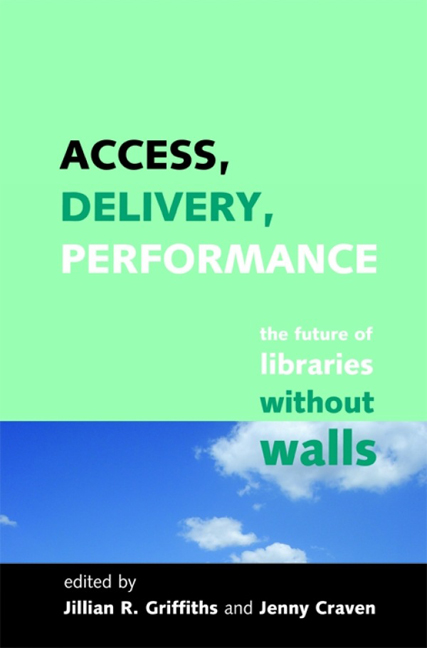Book contents
- Frontmatter
- Contents
- Contributors
- 1 Introduction
- 2 The Library Research Unit at the University of Lancaster, 1967–1972: a memoir
- Theme 1 Libraries, learning and distance learning
- 3 Alice in www.land: reflections on ten years of developing library services for distance learners
- 4 Putting the ‘e’ into libraries and learning: study, pedagogy, content and services in the digital age
- Theme 2 Widening access to information
- Theme 3 Changing directions of information delivery
- Theme 4 Performance, quality and leadership
- Peter Brophy: a selected bibliography
- Index
3 - Alice in www.land: reflections on ten years of developing library services for distance learners
from Theme 1 - Libraries, learning and distance learning
Published online by Cambridge University Press: 08 June 2018
- Frontmatter
- Contents
- Contributors
- 1 Introduction
- 2 The Library Research Unit at the University of Lancaster, 1967–1972: a memoir
- Theme 1 Libraries, learning and distance learning
- 3 Alice in www.land: reflections on ten years of developing library services for distance learners
- 4 Putting the ‘e’ into libraries and learning: study, pedagogy, content and services in the digital age
- Theme 2 Widening access to information
- Theme 3 Changing directions of information delivery
- Theme 4 Performance, quality and leadership
- Peter Brophy: a selected bibliography
- Index
Summary
Introduction
This story begins in 1998 at a time of tremendous change and challenge in the provision of library services to distance education students. At the Open University Library we were embarking on a journey which at the outset appeared to have a relatively clear route and destination. Universities are, however, large and complex organizations and operate in a volatile and increasingly political context. The journey had more than a few twists and turns along the way and we are taking the opportunity of writing this chapter to reflect on our progress and some of the challenges we have encountered. This is particularly appropriate in a volume dedicated to Peter Brophy, who has been such an inspiration to all of us working in this field.
A tale of two Alices
In the beginning it was all about equity and access for distance learning students. This was both an ethical issue – the rights of these learners to have an equivalent service to that enjoyed by campus students – and an issue about academic standards and ‘graduateness’. The challenge was to abolish, or at least minimize, distance for those learners. It was characterized at the time by a tale of two Alices.
The Follett Report of 1993 (the Joint Funding Councils’ Libraries Review Group, 1993) reviewed the provision of library services in UK higher education and made some important recommendations about investment, particularly regarding information technology, with the plan to set up the Joint Information Systems Committee (JISC). The report predicted the importance of the virtual library and presented a series of scenarios in this context, one of which introduces Alice, an undergraduate student of the future: Alice has just received feedback, online, from her tutor on her latest assignment:
He suggests two further references. Alice switches to the library catalogue. Fortunately one reference is available on the campus textbook server: she requests it for printing in the hall of residence. The other reference takes longer to locate: it is an electronic journal article and will cost £10 for immediate transmission…. She calls up the abstract/front page option on screen, decides it will be worth reading, swipes the credit card and in a few seconds the article is on screen, transmitted over the networks from an electronic document delivery exchange in Colorado.
(Joint Funding Councils’ Libraries Review Group,1993, 60)Information
- Type
- Chapter
- Information
- Access, Delivery, PerformanceThe Future of Libraries Without Walls, pp. 23 - 38Publisher: FacetPrint publication year: 2008
